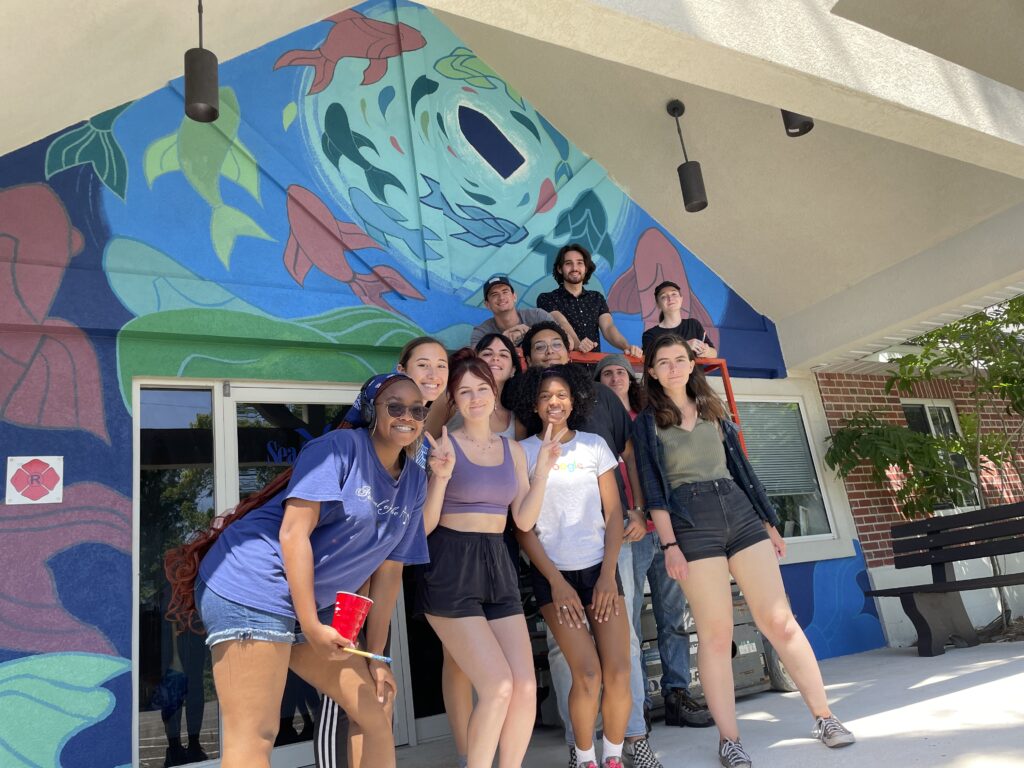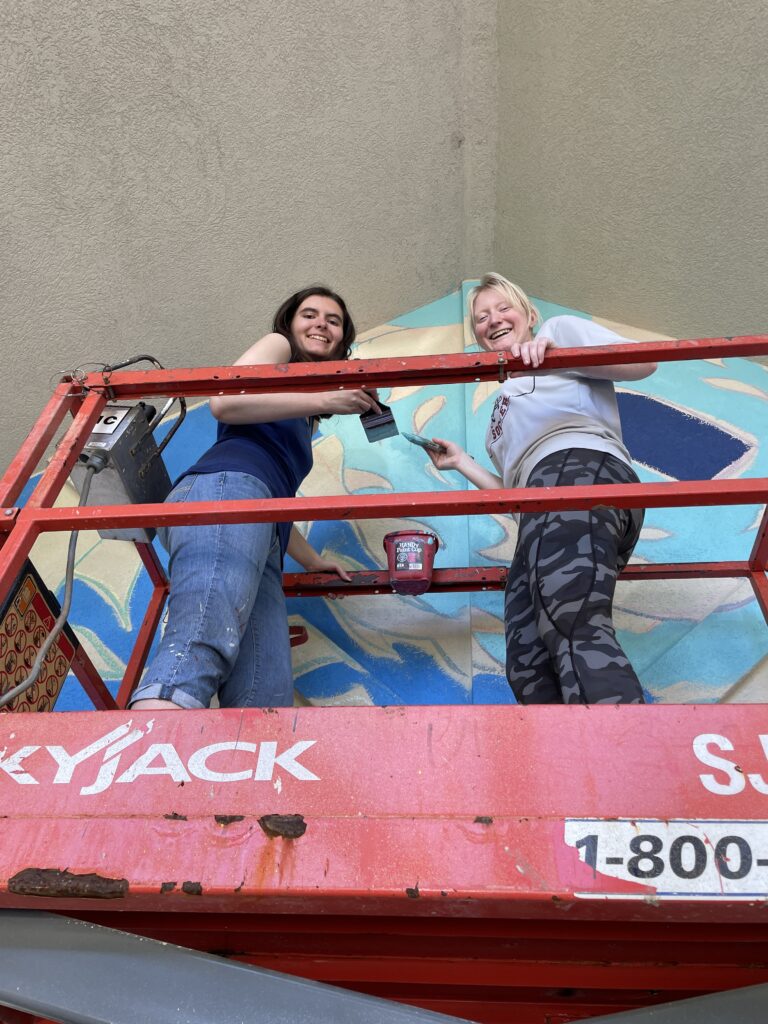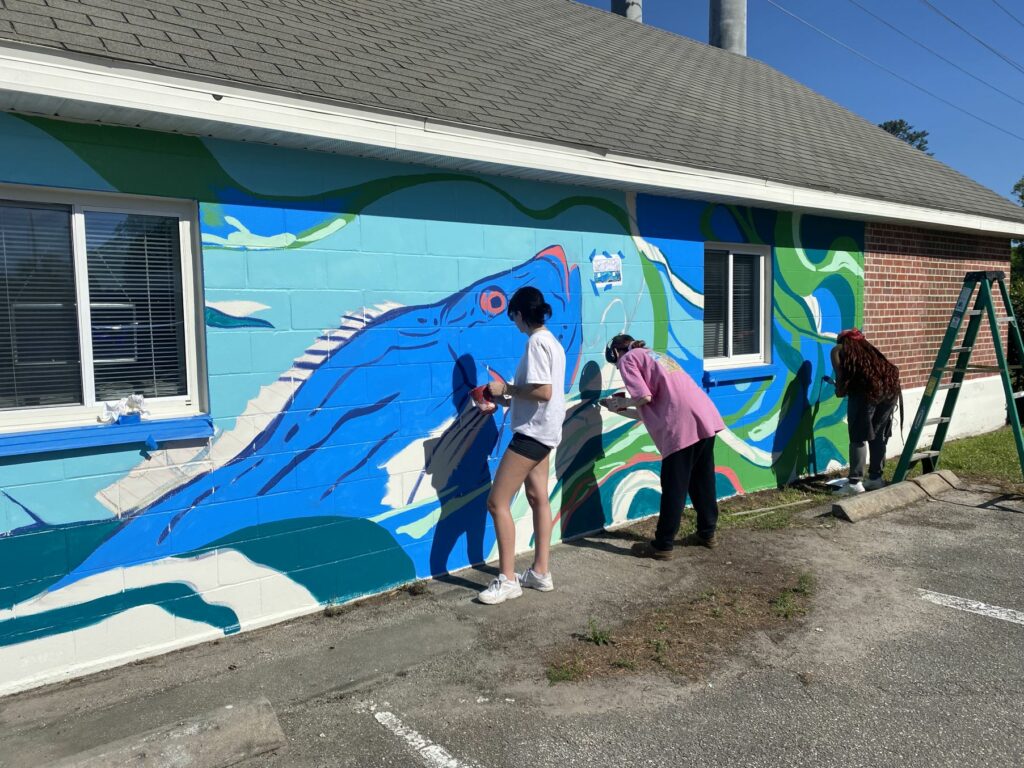Creativity is essential in advancing the dissemination of scientific knowledge. The artistic visualization of science can make information accessible to various communities. Simultaneously, the intricacies of scientific detail can fuel artistic inspiration – Guy Harvey is a prime example of an artist who harnesses his background in fisheries and marine biology to illustrate realistic marine life in his artwork.
To conceptualize the intersection between art and science, Florida Sea Grant recruited student artists at the University of Florida to paint ocean-inspired murals on the building’s exterior walls.

Artists from Prof. Morrisroe’s Site-Specific Painting class celebrate the completion of the Florida Sea Grant mural. Photo by Prof. Julia Morrisroe.
“Aside from supporting the integration of science in the arts and student training, I was intrigued by how our researchers can gain valuable insights on communication that can strengthen the effectiveness and relevance of their programs to the public,” says Dr. Sherry Larkin, Director of Florida Sea Grant.
Dr. Larkin envisioned Florida Sea Grant’s visual communication initiative after being acquainted with Professor Julia Morrisroe’s Site-Specific Painting class, a painting course designed to explore the relationship between painting, architecture, performance, and interactivity. An integral component of the class facilitated the conversations between student artists and researchers.
“This project aims to make science information less esoteric while prompting students to realize academia can be human,” says Professor Morrisroe. “This project specifically allows artists to move away from self and identity and engage with different communities of knowledge.”
In the preliminary stages of the mural designs, sixteen student artists interviewed five Florida Sea Grant faculty to learn more about coastal and marine topics. The students integrated the information they learned into their art.
The interwovenness and fluidity of the mural were inspired by the interactions between seagrass habitats and different species, especially fish.
Lauren Keeling

Sophia DeLeon (left) and Savannah Langstrom (right) work on a mural inspired by the interactions between anglers and fisheries. Photo by Prof. Julia Morrisroe.
Sophia DeLeon, a senior art and history major, now has her piece exhibited at the front entrance of the Florida Sea Grant building, depicting a vibrant collection of marine life facing toward the underside of a boat.
DeLeon met with Nick Haddad from Return ‘Em Right, a program led by Florida Sea Grant that aims to increase the survival of reef fish caught and released in the Gulf of Mexico. After speaking with Haddad, she was determined to incorporate the concepts of sustainable fisheries and human dimensions in marine sciences.
“When I spoke with Haddad, I learned about barotrauma and how anglers can unintentionally endanger fish when they reel them up quickly. I incorporated this element in my work, where the boat is looming above the fish. I hope my mural reminds people that our choices within our sphere impact other spheres.”
While working on the mural design, DeLeon had to also dive a little deeper into the anatomy of fish – a topic that was relatively unfamiliar yet interesting to her.
“When I first sat down to draw this composition, it was originally very simplistic. The other mural designed by Lauren Keeling, had more realistic drawings, so her designs inspired me to learn more about the physical anatomy of marine life. It ended up being an exciting exercise that I am interested in learning more about,” says DeLeon.
Lauren Keeling’s talents as a naturalist artist stem from her pursual of an art degree with a minor in wildlife ecology and conservation. As the mastermind behind the exterior back wall’s mural, Keeling was drawn to UF Research Affiliate Dr. Laura Reynolds and her research on the interconnectedness of seagrass habitats and fisheries.
“The interwovenness and fluidity of the mural were inspired by the interactions between seagrass habitats and different species, especially fish. After speaking with Dr. Reynolds, I learned how different types of seagrass increase biodiversity and provide food and habitats for many species. I wanted to demonstrate how diverse living organisms interact together instead of independently. In my painting, you can see where I incorporated this element, where the fish and seagrass share a similar movement and blend into each other.”

Lauren Keeling’s mural for the back entrance was inspired by Dr. Laura Reynold’s research on seagrass habitats. Photo by Prof. Julia Morrisroe.
Keeling valued Dr. Reynolds’ ability to share her research throughout the artistic process.
“It was insightful to meet the people behind important marine projects, learn more about their work, and most importantly, be able to ask specific questions. Dr. Reynolds was excellent at clarifying and expanding on certain topics.”
Sixteen students with different creative talents worked on the mural within two weeks. Throughout the process, they observed the intricate steps involved in both science and art.
“Art is as methodical as science. We had to sketch out the lines for the actual mural, figure out how colors interact with each other, deal with numbers and ratios when we were translating the design onto the walls, and adding details,” says junior artist Jo Ingram.
Working on the project also allowed the student artists to reflect on what the mural signifies. For Ingram, she hopes the mural will display the effectiveness of art and science to promote a greater sense of marine science education and stewardship.
“Murals cause you to slow down and embrace your surroundings, which is an important message for marine conservation. Far often, we do not stop to see the beauty within the natural environment, so integrating this philosophical element typically embraced in art, makes science and research much more personable and human.”